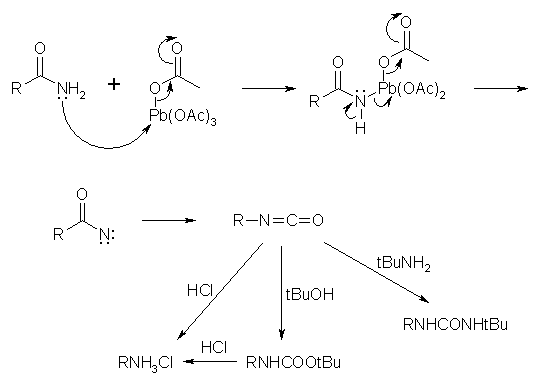
frogfot - 13-1-2006 at 13:32
While doing a project I stumbled upon an interesting reaction, described here:
JACS, 87:5, 1141, 1965
I don't have that article in electronic format (anyone can upload it to ftp?), and theres no idea to retype the procedures.. here I've only extracted
the mechanism:

It's basically a Hoffmann rearrangement where one acts with Pb(OAc)4 on an amide in presence of a weak base (triethylamine). Reaction mix is heated at
50-60*C in a solvent: either in tBuOH (to get RNHCOOtBu) or in DMF (to get R-N=C=O)
I'd guess the base can be substituted by say sodium acetate (I used it as a base in different Hoffmann rearrangement**). However, there could be
problems with choise of the solvent, it should be a polar solvent that dissolves all reagents.*** Maby water can act as the solvent.. dunno..
The isocyanate (R-N=C=O) can be hydrolised by a strong acid without isolation to get the hydrochloride (RNH3Cl) which can be easily purifyed by
acid/base wash.
I havn't tested this reaction yet. Anyway, any further thoats on how to simplify the reaction conditions to make this route more OTC? IIRC we had a
thread on lead tetraacetate preparation..
**RCONH2 was converted to RNHCOOMe by mixing the amide with NBS, methanol and sodium acetate in DMF at 0*C and heated at 60*C.
***primary alcohols can't be used since article says they react faster with Pb(OAc)4 faster than does the amide.
[Edited on 13-1-2006 by frogfot]
runlabrun - 15-1-2006 at 19:20
looks interesting -->
http://rapidshare.de/files/11137123/ja01083a042.pdf.html
-rlr
Nick F - 21-1-2006 at 08:27
Standard Hoffmann rxn looks more OTC to me. What benefits does this one have?
frogfot - 22-1-2006 at 16:04
Thanks for sharing the article runlabrun.
Nick F, you're right.. and on second thoat it would be too much work to optimise this synth to be OTC..
But this synth offers new rxn conditions. For example as solvents they use tert-butyl alcohol or DMF, this is superior conditions if you have a very
big nonpolar amide. The standard Hoffmann rxn works only for water soluble compounds or amides with less than 7C (IIRC).
There is an old modification of the Hoffmann rxn for compounds with more than 7C where one uses dry methanol or ethanol, 1 equivalent amide, 2 eq
sodium metal and 1 eq bromine... so compared to this, the Pb(OAc)4 route seems a bit cheaper.
I'd also guess that hypochlorite is a harsher oxidiser than Pb(OAc)4, which would make it possible to use the latter with more functionalised amides
(ones that have functional groups sensitive to oxidation).. correct me if I'm wrong though.
Nick F - 23-1-2006 at 09:11
That's a good point about the solubility of the amides (I wonder if a phase transfer catalyst could be used in Hoffmann degradations for larger
amides?).
As far as harshness of the oxidiser is concerned, that will probably depend on what functional groups you have. Lead acetate seems like the kind of
thing which would attack alkenes (does hypochlorite? I can't remember!).
frogfot - 29-1-2006 at 10:41
Phase transfer catalysts seems like an overkill.. On an other thoat, it may just be easier to use mixtures of solvents (add some inert solvent that
will increase solubility of the amide while keeping the hypochlorite source still soluble).
Checked an org book on oxidation of alkenes. Couldn't find anything on hypochlorite oxidation, but there was mentioned conditions with
Pb(OAc)4/trifluoro acetic acid that oxidised PhCH=CH2 to PhCH2CHO.. It's a bit harsher than conditions in article but generally you may be right about
lead acetate attacking double bonds..

